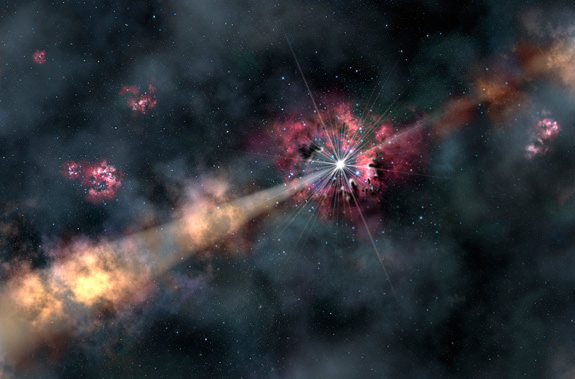Once upon a time, more than 12.7 billion years ago, a star was poised on the edge of extinction. It made its home in a galaxy too small, too faint and too far away to even be spotted by the Hubble Space Telescope. Not that it would matter, because this star was going to end its life before the Earth formed. As it blew itself apart, it expelled its materials in twin jets which ripped through space at close to the speed of light – yet the light of its death throes outshone its parent galaxy by a million times.
“This star lived at a very interesting time, the so-called dark ages just a billion years after the Big Bang,” says lead author Ryan Chornock of the Harvard-Smithsonian Center for Astrophysics (CfA).
“In a sense, we’re forensic scientists investigating the death of a star and the life of a galaxy in the earliest phases of cosmic time,” he adds.
When this unsung star expired, it created one of the scariest things in astronomy… a gamma-ray burst (GRB). However, it wasn’t just a normal, garden variety GRB – it was long one, lasting more than four minutes. After century upon century of travel, the light reached our little corner of the Universe and was detected by NASA’s Swift spacecraft on June 6th. Chornock and his team quickly organized follow-up observations by the MMT Telescope in Arizona and the Gemini North telescope in Hawaii.
“We were able to get right on target in a matter of hours,” Chornock says. “That speed was crucial in detecting and studying the afterglow.”
Time to kick back and have a smoke? In a sense. The “afterglow” of a GRB happens when the jets impact the surrounding gas in an almost tsunami-like effect. As it sweeps up the material, it begins to heat and glow. As this light traverses the parent galaxy, it impacts clouds of interstellar gas, illuminating their spectra. Through these chemical signatures, astronomers are able to ascertain what gases the distant galaxy may have contained. As we know, all chemical elements heavier than hydrogen, helium, and lithium are the product of stars. Researchers refer to this as “metal content” and it takes a certain amount of time to accumulate. In the scheme of creation, the elements necessary for life – carbon and oxygen – didn’t exist. What Chornock and his team discovered was the GRB galaxy was host to only about a tenth of the “metals” in our solar system. What does that mean? In the eyes of the astronomers, rocky planets might have been able to form in that far away galaxy, but chances are good that life could not.
“At the time this star died, the universe was still getting ready for life. It didn’t have life yet, but was building the required elements,” says Chornock.
At a redshift of 5.9, or a distance of 12.7 billion light-years, GRB 130606A is one of the most distant gamma-ray bursts ever found.
“In the future we will be able to find and exploit even more distant GRBs with the planned Giant Magellan Telescope,” says Edo Berger of the CfA, a co-author on the publication.
Original Story Source: Harvard Smithsonian Center for Astrophysics News Release.


As Spock would say . . . fascinating . . . .
Here’s the relevant paper (PDF):
GRB 130606A as a Probe of the Intergalactic Medium and the Interstellar Medium in a Star-forming Galaxy in the First Gyr After the Big Bang.
Ugh. Why do they always have to make it about life? The really interesting information in this paper is what it suggests about the period of reionization. The ability to get a spectrum from this GRB Llowed the researchers to examine the transparency of the universe at different redshifts and determine that reionization happened at different rates in different regions, creating pockets of higher and lower trabsparency. This local variation is something we are only now beginning to observe.
Because life is amazingly important?
But this doesn’t tell us anything important or new about life (we already know that early stars and galaxies are relatively metal-poor). It does, however, tell us new and important things about the development of the early universe. I read the paper and don’t remember it even mentioning life — that’s just a ploy by the university PR office.
It makes to relevant to people reading the story. Not everyone knows that the early universe was metal poor. The blog is targeted at space enthusiasts, not scientists. :v)
From age gone by, a snapshot delivered by a 12+B year-old Galaxy past, journeyed from time-zone of “metal” poor phase, then cast. One galaxy of youth spent, perhaps hosting natal star-worlds round. But “chance” of life-biospheres, then, improbably found. From phantom-beam, a message with illuminating treasure, from sun-bursts revealing measure. Through insightful flash, sent before material Life ere awakened, the curtain further opened on Earth’s cosmic present: brilliantly spotlighted, Life’s timely debut of epic story, performance of its living drama, as by careful script, on a grand stage of spectacular placement.
The heroic, sweeping saga of material Life’s developed moment in eternity!
“At the time this star died, the universe was still getting ready for life. It didn’t have life yet, but was building the required elements,” – Ryan Chornock, CFA.
(So well written, a pleasure to read.)